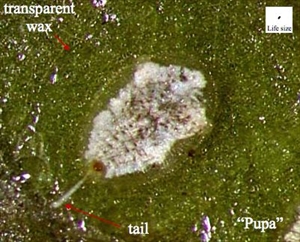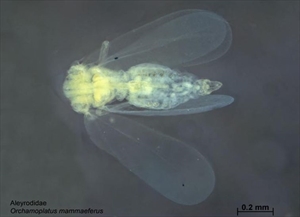- Narrow distribution. On many trees, shrubs and ornamentals. Probably, a minor pest, but little research.
- Adults and nymphs suck the sap causing the leaves to turn and distort; on croton, and other ornamentals, reduces quality.
- Eggs on stalks, laid in rings. Nymphs, at first, active 'crawlers', later, oval, flat, on underside of leaves; pupae, oval, about 0.75 mm long, brownish-yellow, waxy with a white 'tail'. Adults, yellow with red eyes and white, powdery wings.
- Spread by crawlers, or carried by wind, vehicles, animals, birds, on clothes, and the trade in plants.
- Natural enemies: several ladybird beetle predators.
- Cultural control: if pesticides used, remove the most infested leaves before spraying.
- Chemical control: use soap solution, horticulture or white oils (see Fact Sheet no. 56). Note, insecticides will kill natural enemies and probably make the problem worse.
Pacific Pests, Pathogens and Weeds - Online edition
Pacific Pests, Pathogens, Weeds & Pesticides
Croton whitefly (335)
Croton whitefly
Orchamoplatus mammaeferus; previously, Aleuroplatus samoanus and Orchamus samoanus.
AUTHOR Grahame Jackson
1Information from Swaine G (1971) Agricultural Zoology in Fiji. Her Majesty's Stationery Office. London; and CABI (2015) Orchamoplatus mammaeferus (croton whitefly). Crop Protection Compendium. (https://www.cabi.org/cpc/datasheet/37757); and Aleyrodidae: Key to the genera. USDA, APHIS, PPQ. (http://keys.lucidcentral.org/keys/v3/whitefly/key/Aleyrodid%20Pupal%20Key%20to%20the%20Genera/Media/Html/Orchamoplatus.htm). Photo 1 Croton whitefly (Orchamoplatus mammaeferus) California Department of Food and Agriculture. Photo 2 MAF Plant Health & Environment Laboratory (2011) Croton Whitefly (Orchamoplatus mammaeferus): PaDIL - (http://www.padil.gov.au).
Produced with support from the Australian Centre for International Agricultural Research under project PC/2010/090: Strengthening integrated crop management research in the Pacific Islands in support of sustainable intensification of high-value crop production, implemented by the University of Queensland and the Secretariat of the Pacific Community.





